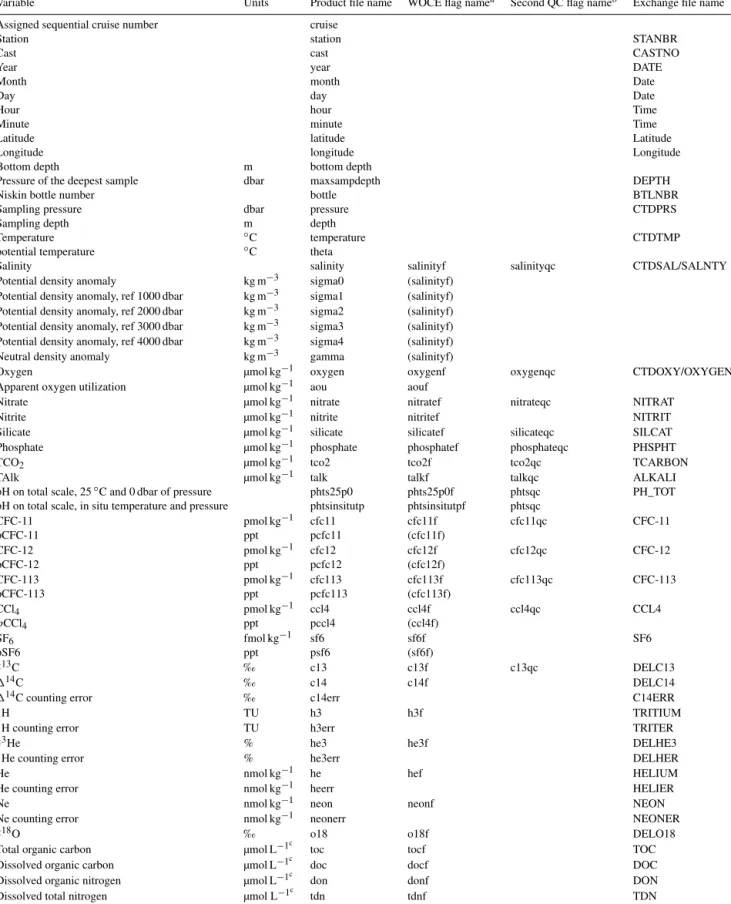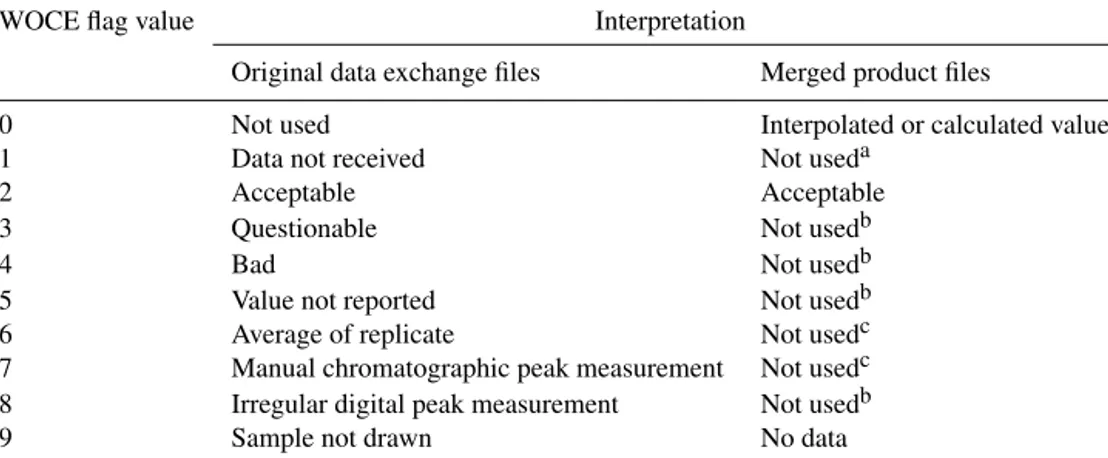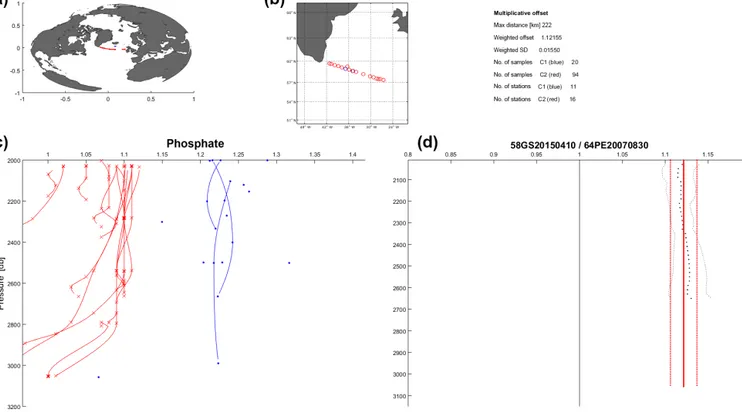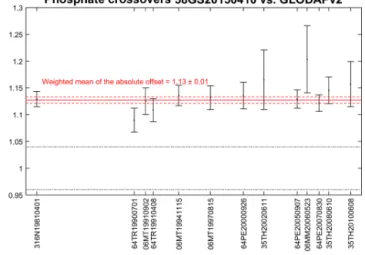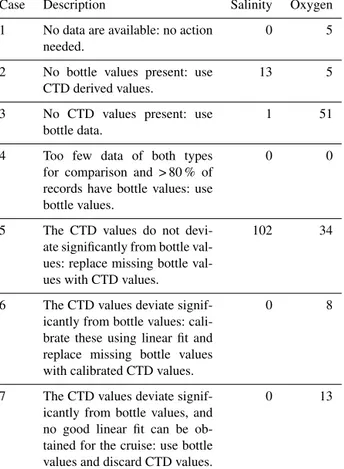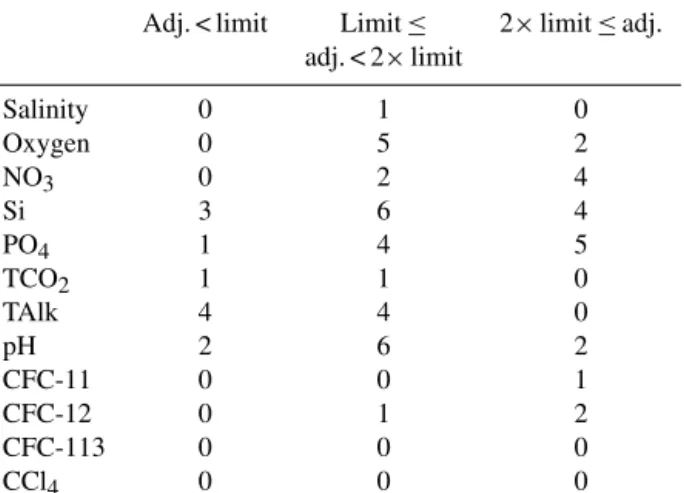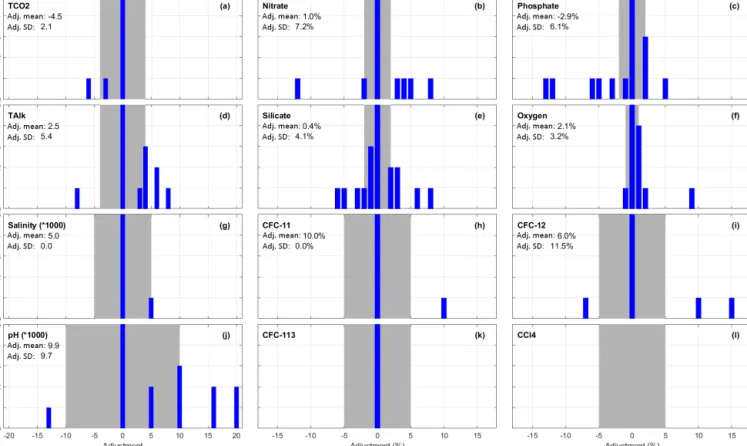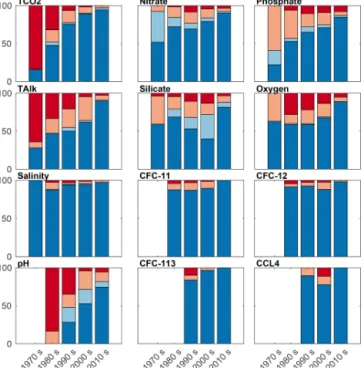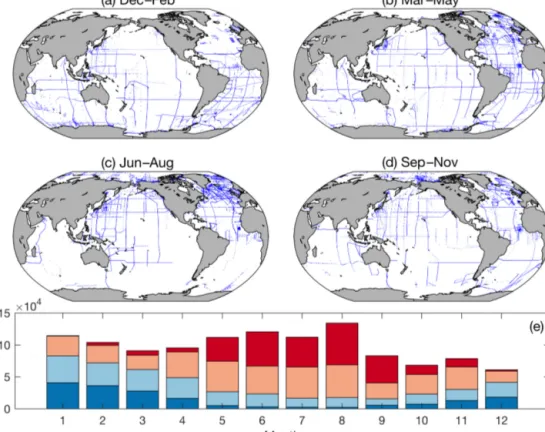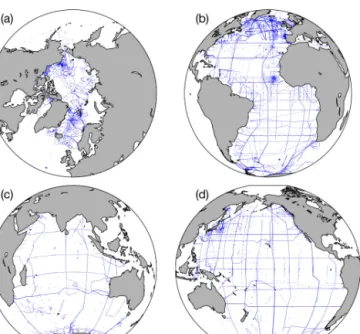https://doi.org/10.5194/essd-11-1437-2019
© Author(s) 2019. This work is distributed under the Creative Commons Attribution 4.0 License.
GLODAPv2.2019 – an update of GLODAPv2
Are Olsen1, Nico Lange2, Robert M. Key3, Toste Tanhua2, Marta Álvarez4, Susan Becker5, Henry C. Bittig6, Brendan R. Carter7,8, Leticia Cotrim da Cunha9, Richard A. Feely8, Steven van Heuven10, Mario Hoppema11, Masao Ishii12, Emil Jeansson13, Steve D. Jones1, Sara Jutterström14, Maren K. Karlsen1, Alex Kozyr15, Siv K. Lauvset13,1, Claire Lo Monaco16,
Akihiko Murata17, Fiz F. Pérez18, Benjamin Pfeil1, Carsten Schirnick2, Reiner Steinfeldt19, Toru Suzuki20, Maciej Telszewski21, Bronte Tilbrook22, Anton Velo18, and Rik Wanninkhof23
1Geophysical Institute, University of Bergen and Bjerknes Centre for Climate Research, Bergen, Norway
2GEOMAR Helmholtz Centre for Ocean Research Kiel, Kiel, Germany
3Atmospheric and Oceanic Sciences, Princeton University, Princeton, NJ, 08540, USA
4Instituto Español de Oceanografía, A Coruña, Spain
5UC San Diego, Scripps Institution of Oceanography, San Diego, CA 92093, USA
6Leibniz Institute for Baltic Sea Research Warnemünde, Rostock, Germany
7Joint Institute for the Study of the Atmosphere and Ocean, University Washington, Seattle, Washington, USA
8Pacific Marine Environmental Laboratory, National Oceanic and Atmospheric Administration, Seattle, Washington, USA
9Faculdade de Oceanografia, Universidade do Estado do Rio de Janeiro, Rio de Janeiro (RJ), Brazil
10Centre for Isotope Research, Faculty of Science and Engineering, University of Groningen, Groningen, the Netherlands
11Alfred Wegener Institute Helmholtz Centre for Polar and Marine Research, Bremerhaven, Germany
12Oceanography and Geochemistry Research Department, Meteorological Research Institute, Japan Meteorological Agency, Tsukuba, Japan
13NORCE Norwegian Research Centre, Bjerknes Centre for Climate Research, Bergen, Norway
14IVL Swedish Environmental Research Institute, Gothenburg, Sweden
15NOAA National Centers for Environmental Information, Silver Spring, MD, USA
16LOCEAN, CNRS, Sorbonne Université, Paris, France
17Research Institute for Global Change, Japan Agency for Marine-Earth Sciences and Technology, Yokosuka, Japan
18Instituto de Investigaciones Marinas, IIM – CSIC, Vigo, Spain
19University of Bremen, Institute of Environmental Physics, Bremen, Germany
20Marine Information Research Center, Japan Hydrographic Association, Tokyo, Japan
21International Ocean Carbon Coordination Project, Institute of Oceanology of Polish Academy of Sciences, Sopot, Poland
22CSIRO Oceans and Atmosphere and Antarctic Climate and Ecosystems Co-operative Research Centre, University of Tasmania, Hobart, Australia
23Atlantic Oceanographic and Meteorological Laboratory, National Oceanic and Atmospheric Administration, Miami, USA
Correspondence:Are Olsen (are.olsen@uib.no) Received: 23 April 2019 – Discussion started: 30 April 2019
Revised: 7 August 2019 – Accepted: 12 August 2019 – Published: 25 September 2019
Abstract. The Global Ocean Data Analysis Project (GLODAP) is a synthesis effort providing regular compi- lations of surface to bottom ocean biogeochemical data, with an emphasis on seawater inorganic carbon chem- istry and related variables determined through chemical analysis of water samples. This update of GLODAPv2,
v2.2019, adds data from 116 cruises to the previous version, extending its coverage in time from 2013 to 2017, while also adding some data from prior years. GLODAPv2.2019 includes measurements from more than 1.1 million water samples from the global oceans collected on 840 cruises. The data for the 12 GLODAP core variables (salinity, oxygen, nitrate, silicate, phosphate, dissolved inorganic carbon, total alkalinity, pH, CFC-11, CFC-12, CFC-113, and CCl4) have undergone extensive quality control, especially systematic evaluation of bias.
The data are available in two formats: (i) as submitted by the data originator but updated to WOCE exchange format and (ii) as a merged data product with adjustments applied to minimize bias. These adjustments were derived by comparing the data from the 116 new cruises with the data from the 724 quality-controlled cruises of the GLODAPv2 data product. They correct for errors related to measurement, calibration, and data handling practices, taking into account any known or likely time trends or variations. The compiled and adjusted data product is believed to be consistent to better than 0.005 in salinity, 1 % in oxygen, 2 % in nitrate, 2 % in silicate, 2 % in phosphate, 4 µmol kg−1in dissolved inorganic carbon, 4 µmol kg−1in total alkalinity, 0.01–0.02 in pH, and 5 % in the halogenated transient tracers. The compilation also includes data for several other variables, such as isotopic tracers. These were not subjected to bias comparison or adjustments.
The original data, their documentation and DOI codes are available in the Ocean Carbon Data System of NOAA NCEI (https://www.nodc.noaa.gov/ocads/oceans/GLODAPv2_2019/, last access: 17 September 2019).
This site also provides access to the merged data product, which is provided as a single global file and as four regional ones – the Arctic, Atlantic, Indian, and Pacific oceans – under https://doi.org/10.25921/xnme-wr20 (Olsen et al., 2019). The product files also include significant ancillary and approximated data. These were obtained by interpolation of, or calculation from, measured data. This paper documents the GLODAPv2.2019 methods and provides a broad overview of the secondary quality control procedures and results.
1 Introduction
The oceans mitigate climate change by absorbing CO2cor- responding to a significant fraction of anthropogenic CO2
emissions (Gruber et al., 2019; Le Quéré et al., 2018) and most of the excess heat in the Earth system caused by the en- hanced greenhouse effect resulting from the fraction of CO2 and other greenhouse gases remaining in the atmosphere (Cheng et al., 2017). The objective of GLODAP (Global Ocean Data Analysis Project, https://www.glodap.info/, last access: 17 September 2019) is to ensure provision of high- quality and bias-corrected water column bottle data from the ocean surface to bottom that document the evolving changes in physical and chemical ocean properties ascribed to global change, e.g., the inventory of the excess CO2 in the ocean, natural oceanic carbon, ocean acidification, venti- lation rates, oxygen levels, and vertical nutrient transports.
The core, quality-controlled, and bias-corrected GLODAP variables are salinity, dissolved oxygen, inorganic macronu- trients (nitrate, silicate, and phosphate), seawater CO2chem- istry variables (dissolved inorganic carbon – TCO2, total al- kalinity – TAlk, and pH on the total H+scale), and the halo- genated transient tracers CFC-11, CFC-12, CFC-113, and CCl4.
Other chemical tracers have been measured on the cruises included in GLODAP. A subset of these data is also dis- tributed as part of the product but has not been extensively quality controlled or checked for measurement biases in this effort. Examples include stable isotopes of carbon and oxy- gen (δ13C and δ18O), radioisotopes (14C, 3H,3He), noble
gases (He, Ne), and organic material including total organic carbon (TOC), dissolved organic carbon (DOC), total dis- solved nitrogen (TDN), and chlorophylla(Chla). For some of these variables, better sources of data may exist. In par- ticular, for helium isotope and tritium data the product by Jenkins et al. (2019) should be used. Measurements of sul- fur hexafluoride (SF6) are also included. This is an impor- tant transient tracer as its atmospheric (and ocean) levels are still increasing, in contrast to CFC-11 and CFC-12 for which emissions were curbed following the implementation of the Montreal Protocol (Prinn et al., 2018). GLODAP also in- cludes derived variables to facilitate interpretation, such as potential density anomalies and apparent oxygen utilization (AOU). A full list of variables included in the product is pro- vided in Table 1.
The first version of GLODAP, GLODAPv1.1, was re- leased in 2005 (Key et al., 2004; Sabine et al., 2005). It contains data from 115 cruises with biogeochemical mea- surements from the global ocean. The vast majority of these are the sections covered during the World Ocean Circula- tion Experiment and the Joint Global Ocean Flux Study (WOCE/JGOFS) in the 1990s, but data from important
“historical” cruises were also included, such as from the Geochemical Ocean Sections Study (GEOSECS), Transient Traces in the Ocean (TTO), and South Atlantic Ventilation Experiment (SAVE). The second version of GLODAP, GLO- DAPv2, was released in 2016 (Key et al., 2015; Lauvset et al., 2016; Olsen et al., 2016) with data from 724 scientific cruises: those included in GLODAPv1.1, those amassed for the Carbon in the Atlantic Ocean (CARINA) data synthesis
Table 1.Variables in the GLODAPv2.2019 comma separated (csv) product files, their units, short and flag names, and corresponding names in the individual cruise exchange files. In the MATLAB product files that are also supplied a “G2” has been added to every variable name.
Variable Units Product file name WOCE flag namea Second QC flag nameb Exchange file name
Assigned sequential cruise number cruise
Station station STANBR
Cast cast CASTNO
Year year DATE
Month month Date
Day day Date
Hour hour Time
Minute minute Time
Latitude latitude Latitude
Longitude longitude Longitude
Bottom depth m bottom depth
Pressure of the deepest sample dbar maxsampdepth DEPTH
Niskin bottle number bottle BTLNBR
Sampling pressure dbar pressure CTDPRS
Sampling depth m depth
Temperature ◦C temperature CTDTMP
potential temperature ◦C theta
Salinity salinity salinityf salinityqc CTDSAL/SALNTY
Potential density anomaly kg m−3 sigma0 (salinityf)
Potential density anomaly, ref 1000 dbar kg m−3 sigma1 (salinityf) Potential density anomaly, ref 2000 dbar kg m−3 sigma2 (salinityf) Potential density anomaly, ref 3000 dbar kg m−3 sigma3 (salinityf) Potential density anomaly, ref 4000 dbar kg m−3 sigma4 (salinityf)
Neutral density anomaly kg m−3 gamma (salinityf)
Oxygen µmol kg−1 oxygen oxygenf oxygenqc CTDOXY/OXYGEN
Apparent oxygen utilization µmol kg−1 aou aouf
Nitrate µmol kg−1 nitrate nitratef nitrateqc NITRAT
Nitrite µmol kg−1 nitrite nitritef NITRIT
Silicate µmol kg−1 silicate silicatef silicateqc SILCAT
Phosphate µmol kg−1 phosphate phosphatef phosphateqc PHSPHT
TCO2 µmol kg−1 tco2 tco2f tco2qc TCARBON
TAlk µmol kg−1 talk talkf talkqc ALKALI
pH on total scale, 25◦C and 0 dbar of pressure phts25p0 phts25p0f phtsqc PH_TOT
pH on total scale, in situ temperature and pressure phtsinsitutp phtsinsitutpf phtsqc
CFC-11 pmol kg−1 cfc11 cfc11f cfc11qc CFC-11
pCFC-11 ppt pcfc11 (cfc11f)
CFC-12 pmol kg−1 cfc12 cfc12f cfc12qc CFC-12
pCFC-12 ppt pcfc12 (cfc12f)
CFC-113 pmol kg−1 cfc113 cfc113f cfc113qc CFC-113
pCFC-113 ppt pcfc113 (cfc113f)
CCl4 pmol kg−1 ccl4 ccl4f ccl4qc CCL4
pCCl4 ppt pccl4 (ccl4f)
SF6 fmol kg−1 sf6 sf6f SF6
pSF6 ppt psf6 (sf6f)
δ13C ‰ c13 c13f c13qc DELC13
114C ‰ c14 c14f DELC14
114C counting error ‰ c14err C14ERR
3H TU h3 h3f TRITIUM
3H counting error TU h3err TRITER
δ3He % he3 he3f DELHE3
3He counting error % he3err DELHER
He nmol kg−1 he hef HELIUM
He counting error nmol kg−1 heerr HELIER
Ne nmol kg−1 neon neonf NEON
Ne counting error nmol kg−1 neonerr NEONER
δ18O ‰ o18 o18f DELO18
Total organic carbon µmol L−1c toc tocf TOC
Dissolved organic carbon µmol L−1c doc docf DOC
Dissolved organic nitrogen µmol L−1c don donf DON
Dissolved total nitrogen µmol L−1c tdn tdnf TDN
Chlorophylla µg kg−1c chla chlaf CHLORA
aThe only derived variable assigned a separate WOCE flag is AOU as it depends strongly on both temperature and oxygen (and less strongly on salinity). For the other derived variables, the applicable WOCE flag is given in parentheses.bSecondary QC flags indicate whether data have been subjected to full secondary QC (1) or not (0), as described in Sect. 3.cUnits have not been checked; some values are in micromoles per kilogram (for TOC, DOC, DON, TDN) or microgram per liter (for Chla) are probable.
(Key et al., 2010); those amassed for the Pacific Ocean In- terior Carbon (PACIFICA) synthesis (Suzuki et al., 2013), and data from 168 additional cruises. The additional cruises include many collected within the framework of the “repeat hydrography” program (Talley et al., 2016), instigated in the early 2000s as part of CLIVAR and since 2007 organized as the Global Ocean Ship-based Hydrographic Investigations Program (GO-SHIP). Both GLODAPv1.1 and GLODAPv2 data were released in three formats: (i) as submitted by the data originator but reformatted to WOCE exchange format (Swift and Diggs, 2008) and subjected to primary quality control to flag outliers, (ii) as a merged data product with bias minimization adjustments applied, and (iii) as globally mapped climatological distributions. We refer to the first as the original data, to the second as the data product, and to the third as the mapped product.
The GLODAP products have been widely used. The first version formed the basis for the first data-based estimate of the global ocean inventory of anthropogenic carbon (Sabine et al., 2004), and the descriptive paper on GLODAPv1.1 (Key et al., 2004) has been cited more than 800 times ac- cording to Web of Science (Clarivate Analytics). For GLO- DAPv2, we have registered more than 120 applications. Ex- amples include model evaluation (Beadling et al., 2018;
Goris et al., 2018; Tjiputra et al., 2018; Ward et al., 2018), model initialization (Orr et al., 2017), water mass analy- ses (Jeansson et al., 2017; Peters et al., 2018; Rae and Broecker, 2018), ocean acidification (Fassbender et al., 2017;
García-Ibáñez et al., 2016; Perez et al., 2018) calibration of Argo biogeochemical sensor measurements (Bushinsky et al., 2017; Johnson et al., 2017), calibration of multiple lin- ear regression (MLR) and neural-network-based methods for biogeochemical data estimation (Bittig et al., 2018; Carter et al., 2018; Fry et al., 2016; Sauzède et al., 2017), contextual- ization of paleo-oceanographic data (Glock et al., 2018; Sess- ford et al., 2018), and calculation of inventory, transport, and variability of ocean carbon (DeVries et al., 2017; Fröb et al., 2016, 2018; Gruber et al., 2019; Panassa et al., 2018; Pardo et al., 2017; Quay et al., 2017). A full list of GLODAPv2 citations is provided at https://www.glodap.info/index.php/
glodap-impact/ (last access: 17 September 2019).
Principles and practices for ensuring open access to re- search data have been established, in particular the Find- able, Accessible, Interoperable, Reusable (FAIR) principles (Wilkinson et al., 2016), and are largely adhered to by the oceanographic community. Data are routinely made available on a per cruise basis through national and international data centers. However, the plethora of file formats and different levels of documentation combined with the need to retrieve data on a per cruise basis from different access points limits the realization of the full scientific potential of the data. For biogeochemical data there is the added complexity of differ- ent levels of standardization and calibration, and even vari- able units, such that the comparability between many data sets is poor. Standard operating procedures have been de-
veloped for some variables (Dickson et al., 2007; Hood et al., 2010; Hydes et al., 2012) and certified reference mate- rials (CRMs) exist for seawater TCO2 and TAlk measure- ments (Dickson et al., 2003) and for nutrients in seawa- ter (CRMNS; Aoyama et al., 2012; Ota et al., 2010). Still, biases in data occur. These can arise from poor sampling and general operation practices, calibration procedures, in- strument design, and calculations. The use of CRMs does not by itself ensure accurate measurements of seawater CO2 chemistry (Bockmon and Dickson, 2015), and the CRMNS have only become available recently and are not univer- sally used. For salinity and oxygen, lack of – or improper – conductivity–temperature–depth (CTD) sensor calibration is an additional and widespread problem (Olsen et al., 2016).
For halogenated transient tracers, uncertainties in the stan- dard gas composition, extracted water volume, and purge ef- ficiency typically provide the largest sources of uncertainty.
In addition to bias, occasional outliers occur. In rare cases poor precision can render a set of data unusable. GLODAP deals with these issues by presenting the data in a uniform format, by including any documentation that was either sub- mitted or could be attained, and by subjecting the data to primary and secondary quality control assessments, focusing on precision and consistency, respectively. Adjustments are applied to the data to minimize severe cases of bias.
A total of 12 years separated the release of the two ver- sions of GLODAP. The urgency and complexity of mod- ern climate change issues necessitate more frequent updates.
Ocean carbon uptake responds quickly to annual-to-decadal changes in ocean circulation (Fröb et al., 2016; Landschützer et al., 2015), ocean acidification is progressing at unprece- dented rates and already causing carbonate mineral under- saturation in some regions (Feely et al., 2008; Qi et al., 2017), oxygen minimum zones are rapidly expanding (Bre- itburg et al., 2018), and declining nutrient supply to the eu- photic zone is potentially changing phytoplankton composi- tion in certain large ocean regions (Rousseaux and Gregg, 2015). In addition, improvements in data management prac- tices and increased computational resources are transforming approaches to, and expectations for, integrated data products.
The Surface Ocean CO2Atlas (SOCAT) is a prominent ex- ample in this regard with annual releases and rapid use in global carbon budgets (Bakker et al., 2014, 2016; Le Quéré et al., 2018; Pfeil et al., 2013). GLODAP is also becoming an important source of calibration and validation data for the biogeochemical sensors that are now deployed on au- tonomous platforms. Altogether, regular and rapid updates are important.
This contribution documents the first such regular update of GLODAP, which adds data from 116 new cruises to the 724 included in GLODAPv2 and corrects errors and omis- sions in GLODAPv2. It also forms the basis for the documen- tation of future updates, adopting theEarth System Science Data“living data” format for evolving data sets.
2 Key features of the update
GLODAPv2.2019 (Olsen et al., 2019) contains data from 840 cruises, covering the global ocean from 1972 to 2017. The sampling locations of the 116 cruises added in this update are shown alongside those of GLODAPv2 in Fig. 1, while the coverage in time is shown in Fig. 2. Compared to GLO- DAPv2, the added data are mostly repeat observations and extend the coverage in time. Information on cruises added to this version is provided in Table A1 in the Appendix.
All new cruises were subjected to primary (Sect. 3.1) and secondary (Sect. 3.2) quality control (QC). These procedures remain essentially the same as those for GLODAPv2. How- ever, the secondary QC aimed only to ensure the consistency of the data from the 116 new cruises to GLODAPv2. A con- sistency analysis of the full GLODAPv2.2019 product (as done with the original GLODAPv2 product) has not been carried out, as it would be too demanding in terms of time and resources to allow for frequent updates, particularly in terms of application of inversion results. The QC of GLODAPv2 produced a sufficiently accurate data set that can serve as a reliable reference (this is in fact already done by some inves- tigators to test their newly collected data; e.g., Panassa et al., 2018). The aim is to conduct a full analysis (i.e., including an inversion) again after the completion of the third GO-SHIP survey, currently scheduled to be completed by 2023. Un- til that time, intermediate products like this will be released regularly (every 1 or 2 years). A naming convention has been introduced to distinguish intermediate from full product up- dates. For the latter the version number will change, while for the former the year of release is added.
3 Methods
3.1 Data assembly and primary quality control
The data for the 116 new cruises were retrieved from data centers (typically CCHDO, NCEI, PANGAEA) or submit- ted directly to us. Each cruise is identified by an EX- POCODE. The EXPOCODE is guaranteed to be unique and constructed by combining the country code and platform code with the date of departure in the format YYYYM- MDD. The country and platform codes were taken from the ICES library (https://www.ices.dk/marine-data/vocabularies/
Pages/default.aspx, last access: 17 September 2019).
The individual cruise data files were converted to WOCE exchange format: a comma-delimited ASCII format for CTD and bottle data from hydrographic cruises. GLODAP deals only with bottle data, and their exchange format is briefly reviewed here with full details provided in Swift and Diggs (2008). The first line of each exchange file speci- fies the data type, in the case of GLODAP this is “BOT- TLE”, followed by a date and time stamp and identifica- tion of the person/group who prepared the file, e.g., “PRIN- UNIVRMK” is Princeton University, Robert M. Key. Next
follows the README section. This provides brief cruise- specific information, such as dates, ship, region, method and quality notes for each variable measured, citation informa- tion, and references to any papers that used or presented the data. The README information was typically assembled from the information contained in the metadata submitted by the data originator. In some cases, issues noted during the primary QC and other information such as file update notes are included. The only rule for the README section is that it be concise, informative, and as correct as possible.
The README section is followed by data column headers, their units, and then the actual data. The headers and units are standardized and provided in Table 1 for the variables included in GLODAPv2.2019. Exchange file preparation en- tailed units conversion in some cases, most frequently from milliliters per liter (mL L−1; oxygen) or micromoles per liter (µmol L−1; nutrients) to micromoles per kilogram of seawa- ter (µmol kg−1). The default procedure for nutrients was to use seawater density at reported salinity, an assumed lab tem- perature of 22◦C, and pressure of 1 atm. For oxygen, the fac- tor 44.66 was used for the milliliter to micromole conversion, while for the per liter to per kilogram conversion density based on reported salinity and draw temperatures was pre- ferred, but draw temperature was frequently not reported and potential density was used instead. The potential errors intro- duced in any of these procedures are insignificant. Missing numbers are indicated by -999, with trailing zeros to com- ply with the number format for the variable in question, as specified in Swift and Diggs (2008).
Each data column (except temperature and pressure, which are assumed “good” if they exist) has an associated column of data flags. For the exchange files, these flags conform to the WOCE definitions for water sample bottles and are listed in Table 2. If no such WOCE flags were submitted with the data, they were assigned by us. In any case, incoming files were subjected to primary QC to detect questionable or bad data. This was carried out following Sabine et al. (2005) and Tanhua et al. (2010), primarily by inspecting property–
property plots. Outliers showing up in two or more different such plots were generally defined as questionable and flagged as such. In some cases, outliers were only detected during the secondary QC; the consequential flag changes have then also been applied in the original cruise data files.
3.2 Secondary quality control
The aim for the secondary QC was to identify and correct any significant biases in the data from the 116 new cruises rela- tive to GLODAPv2, while retaining any signal due to time changes. To this end, secondary QC in the form of consis- tency analyses was conducted to identify offsets in the data.
All identified offsets were scrutinized by the GLODAP ref- erence group at a meeting in Seattle in September 2018 in order to decide the adjustments to be applied to correct for the offset (if any). To guide this process, a set of initial mini-
Figure 1.Location of stations in(a)GLODAPv2 released in 2016 and for(b)the new data added in this update.
Table 2.WOCE flags in GLODAPv2.2019 exchange format original data files and product files.
WOCE flag value Interpretation
Original data exchange files Merged product files
0 Not used Interpolated or calculated value
1 Data not received Not useda
2 Acceptable Acceptable
3 Questionable Not usedb
4 Bad Not usedb
5 Value not reported Not usedb
6 Average of replicate Not usedc
7 Manual chromatographic peak measurement Not usedc
8 Irregular digital peak measurement Not usedb
9 Sample not drawn No data
aFlag set to 9 in product files.bData are not included in the GLODAPv2.2019 product files and their flags set to 9.cData are included, but flag set to 2.
Figure 2.Number of cruises per year in GLODAPv2 and GLO- DAPv2.2019.
mum adjustment limits was used (Table 3). These are set ac- cording to the expected measurement precision for each vari- able, and are the same as those used for GLODAPv2, apart from TAlk and pH. For TAlk the limit was lowered from 6 to 4 µmol kg−1to better reflect the current level of precision of TAlk measurements (Bockmon and Dickson, 2015). For pH the limit was raised from 0.005 to 0.01, for reasons dis- cussed in Sect. 3.2.4. In addition to the magnitude of the off- set, factors such as its precision, persistence towards refer- ence cruises, regional dynamics, and the occurrence of time trends or other variations were considered. Thus, not all off-
Table 3.Initial minimum adjustment limits.
Variable Minimum adjustment Salinity 0.005
Oxygen 1 % Nutrients 2 % TCO2 4 µmol kg−1 TAlk 4 µmol kg−1
pH 0.01
CFCs 5 %
sets larger than the initial minimum limits have been adjusted for. A guiding principle for these considerations was to not apply an adjustment whenever in doubt. In some cases, when data and offsets were very precise and the cruise conducted in a region where variability is expected to be small, adjust- ments lower than the minimum limits were applied. Any ad- justment was applied uniformly to all values for a variable and cruise, i.e., an underlying assumption is that cruises suf- fer from either no or a single and constant measurement bias.
Except for where explicitly noted (Sect. 3.3.1), no adjust- ments were changed for data previously included in GLO- DAPv2.
Crossover comparisons, MLRs, and comparison of deep- water averages were used to identify offsets for salinity, oxy- gen, nutrients, TCO2, and TAlk (Sect. 3.2.2 and 3.2.3). For pH, an additional evaluation of the internal consistency of the seawater CO2chemistry variables was used whenever possi- ble (Sect. 3.2.4). For the halogenated transient tracers, exami- nation of surface saturation levels and relationship among the tracers were used to assess the data consistency (Sect. 3.4.5).
For salinity and oxygen, CTD and bottle values were merged into a “hybrid” variable prior to the consistency analyses (Sect. 3.2.1).
3.2.1 Merging of sensor and bottle data
Salinity and oxygen data can be obtained either by analysis of water samples (bottle data) and/or directly from the CTD sensor pack. These two types are merged and presented as a single variable in the product. The merging was conducted prior to the consistency checks, ensuring their internal cali- bration in the product. Note that we did not add data from the high-resolution CTD files (as obtained on the downcast) to the bottle data files. The merging procedures were only ap- plied to the bottle data files, which commonly include values recorded by the CTD at the pressures of the upcast when the water samples are collected. Whenever both CTD and bottle data were present in a data file, the merging step considered the deviation between the two and calibrated the CTD values if required and possible. Altogether seven scenarios are pos- sible, where the fourth never occurred during our analyses, but is included to maintain consistency with GLODAPv2.
The number of cases encountered for each scenario is sum- marized in Sect. 4.1.
1. No data are available: no action needed.
2. No bottle values: use CTD values.
3. No CTD values: use bottle values.
4. Too few data of both types for comparison and more than 80 % of the records have bottle values: use bottle values.
5. The CTD values do not deviate significantly from bottle values: replace missing bottle values with CTD values.
6. The CTD values deviate significantly from bottle val- ues: calibrate CTD values using linear fit with respect to bottle data and replace missing bottle values with the so-calibrated CTD values.
7. The CTD values deviate significantly from bottle val- ues, and no good linear fit can be obtained for the cruise:
use bottle values and discard CTD values.
3.2.2 Crossover analyses
The crossover analyses were conducted with the MATLAB toolbox prepared by Lauvset and Tanhua (2015) and with the GLODAPv2 data product as reference. In areas where a strong trend in salinity was present, the TAlk and TCO2data were salinity normalized following Friis et al. (2003), before crossover analysis.
The toolbox implements the “running-cluster” crossover analysis first described by Tanhua et al. (2010). This analysis compares data from two cruises on a station-by-station ba- sis and calculates a weighted mean offset between the two and its weighted standard deviation. The weighting is based on the scatter in the data such that data that have less scat- ter have a larger influence on the comparison than data with more scatter. Whether the scatter reflects actual variability or data precision is irrelevant in this context as increased scat- ter regardless decreases the confidence in the comparison.
Stations that are compared must be within 2◦ arc distance (∼200 km) of each other, and only deep data are used. This minimizes effects of natural variability. Typically, we used 1500 dbar as the upper depth limit, but in regions where deep mixing occurs (such as the Nordic, Labrador, and Irminger seas) a more conservative limit of 2000 dbar was applied.
As an example, the crossover for phosphate as measured on the two cruises 58GS20150410 and 64PE20070830 is shown in Fig. 3. For phosphate the offset is determined as a ratio.
This is also the case for the other nutrients, oxygen, and the halogenated transient tracers. For salinity, TCO2, TAlk, and pH, absolute offsets are used, in accordance with the proce- dures followed for GLODAPv2. The phosphate values from 58GS20150410 are significantly higher, at 1.12±0.016 times those measured at the 64PE20070830 cruise; this is then the weighted mean offset.
For each of the 116 new cruises, such a crossover com- parison was conducted against all cruises possible in GLO- DAPv2, i.e., all cruises that had stations closer than 2◦ arc distance to any station for the cruise in question. The sum- mary figure for phosphate at 58GS20150410 is shown in Fig. 4. Clearly, the phosphate data measured at this cruise are high when compared to the data measured at all nearby cruises included in GLODAPv2. An offset of this kind, ex- ceeding the initial minimum adjustment limit (Table 3) and with no obvious time trend, qualifies for an adjustment of the data in the merged data product.
3.2.3 Other consistency analyses
A few new cruises had no or very few valid crossovers with GLODAPv2 data. In that situation two other consis- tency analyses were carried out for salinity, oxygen, nutri- ents, TCO2, and TAlk data, namely MLR analyses and deep- water averages, broadly following Jutterström et al. (2010).
For the MLRs, the presence of bias in the data for the cruise in question was identified by comparing the MLR gener-
Figure 3.Example crossover figure, for phosphate for cruises 58GS20150410 (blue) and 64PE20070830 (red), as it was generated during the crossover analysis. Panels(a)and(b)show the station positions; panel(c)shows the data below the upper depth limit (in this case 2000 dbar as the Irminger Sea is a site of active deep mixing; Fröb et al., 2016) as points and the interpolated profiles as lines. Non-interpolated data either did not meet minimum depth separation requirements (Table 4 in Key et al., 2010) or are the deepest sampling depth. The interpolation do not extrapolate to this. Panel (d)shows the mean difference (as a ratio) profile (black, dots) with its standard deviation, and also the weighted mean offset (straight, red) and weighted standard deviation. Summary statistics are provided in(b).
ated with the measured value, while for the deep-water av- erages the approach is trivial. These methods were useful in the data-sparse Arctic and Southern oceans. Both anal- yses were conducted on samples collected below 1500 or 2000 dbar pressure to minimize the effects of natural varia- tions, and both used available GLODAPv2 data from within 2◦ of the cruise in question to generate the MLR or deep- water average. The lower depth limit was set to the deep- est sample for the cruise in question. For the MLRs, all of the abovementioned variables could be included among the independent variables (e.g., for a TAlk MLR, salinity, oxy- gen, nutrients, and TCO2were allowed), with the exact se- lection determined based on the statistical robustness of the fit, as evaluated using the coefficient of determination (r2) and root-mean-square error (RMSE). MLRs that were based on variables that were suspect for the cruise in question were avoided (e.g., if oxygen appeared biased it was not included as an independent variable). The MLRs could be based on 10 to 500 samples, and the robustness of the fit (r2, RMSE) and quantity of fitting data were considered when using the results to guide whether to apply a correction. The same ap- plies for the deep-water averages (i.e., the standard deviation of the mean). MLR and deep-water average results showing offsets above the minimum adjustment limits were carefully
scrutinized, along with any crossover results that existed, to determine whether or not to apply an actual adjustment.
3.2.4 pH scale conversion and quality control
A total of 77 of the 116 new cruises included pH data. For about 30 % of these, the pH data were not supplied on the total scale, and at 25◦C and 0 dbar pressure, which is the GLODAP standard. These data were converted to total pH scale and temperature and pressure of 25◦C and 0 dbar. The conversions were conducted by using CO2SYS (Lewis and Wallace, 1998) for MATLAB (van Heuven et al., 2011) with reported pH and TAlk as inputs, and generating pH output values at total scale at 25◦C and 0 dbar of pressure (named phts25p0 in the product). Whenever TAlk data were miss- ing, these values were approximated as 67 times salinity.
The proportionality (67) is the mean ratio of TAlk to salin- ity in the GLODAPv2 data. This is sufficiently accurate for scale–temperature–pressure conversions. Data for phosphate and silicate are also needed and were, whenever missing, de- termined using CANYON-B (Bittig et al., 2018). The con- version was conducted with the carbonate dissociation con- stants of Lueker et al. (2000), the bisulfate dissociation con- stant of Dickson (1990), and the borate-to-salinity ratio of
Figure 4.Example summary figure, for phosphate crossovers for 58GS20150410 versus the cruises in GLODAPv2 (with cruise EX- POCODE listed on thexaxis sorted according to year the cruise was conducted). The black dots and vertical error bars show the weighted mean offset (as a ratio) and standard deviation for each crossover. The weighted mean of all these offsets is shown in the red line and is 1.13±0.01. The black dashed lines are reference lines for a±4 % (0.96–1.04) offset. The limit for applying an ad- justment for phosphate is half of this,±2 %.
Uppström (1974). These procedures are the same as used for GLODAPv2 (Olsen et al., 2016), except for the CANYON-B estimation of phosphate and silicate.
The secondary quality control of the pH data also followed previous procedures, using a combination of crossovers and internal consistency calculations. The latter were conducted when a cruise had data for TCO2 and TAlk, in addition to pH. Note that internal consistency was only considered for the secondary QC of pH, and not for the secondary QC of TCO2and TAlk. Hence, the adjustments applied for pH are not only a bias correction but also a seawater CO2chemistry consistency correction. This is one factor that makes the sec- ondary quality control of pH data problematic, in particular with regard to the application of a uniform correction for an entire cruise or leg based on offsets in deep data. pH depen- dent offsets between pH determined spectrophotometrically with purified dyes and pH calculated from TCO2and TAlk have recently been found. For example, at a pH of 7.6 the calculated pH is higher by∼0.01 than measured pH (Carter et al., 2018). The causes of these discrepancies are not en- tirely clear, suggestions include deficiencies in dissociation constants used for the seawater CO2chemistry calculations, errors in the total boron-to-salinity ratio, and unknown pro- tolytes affecting the TAlk (Carter et al., 2018; Fong and Dick- son, 2019). Such low pH values exist only in the deep North Pacific Ocean. Here, application of pH corrections based on seawater CO2 consistency considerations could impact the correction. Broadly speaking, the pH data in GLODAP have been obtained using a variety of methods (e.g., potentio-
metric measurements, and spectrophotometric measurements with purified or impure dyes). The pH values produced by these different approaches have documented pH-dependent offsets from one another (Carter et al., 2013; Liu et al., 2011;
Patsavas et al., 2015; Yao et al., 2007) that challenge the via- bility of the uniform adjustments applied (Carter et al., 2018).
While we have continued to apply such uniform offsets for this update, we have chosen the higher initial minimum ad- justment limit of 0.01, which is twice that used for GLO- DAPv2 (0.005), to minimize the possibility of false correc- tions. The full ramifications and a revised strategy for iden- tifying and minimizing bias in pH data is a topic for future development of the GLODAP data synthesis procedures. The full collection of pH values in GLODAPv2.2019 should only be considered to be consistent between cruises to 0.01 to 0.02 pH units.
3.2.5 Halogenated transient tracers
For the halogenated transient tracers (CFC-11, CFC-12, CFC-113, and CCl4; CFCs for short), inspection of surface saturation levels and evaluation of relationships between the tracers for each cruise were used to identify biases, rather than crossover analyses. Crossover analysis is of limited value for these variables given their transient nature and low deep-water concentrations. As for GLODAPv2, the proce- dures were the same as those applied for CARINA (Jeansson et al., 2010; Steinfeldt et al., 2010).
3.3 Merged product generation
The merged product file for GLODAPv2.2019 was created by correcting known issues in the GLODAPv2 merged file, and then appending a merged and bias-corrected file contain- ing the 116 new cruises to this error-corrected GLODAPv2 file.
3.3.1 Updates and corrections for GLODAPv2
Several minor omissions and errors have been identified in the GLODAPv2 data product since its release in early 2016.
Most of these have been corrected in this release. In addi- tion, some recently available data have been added for a few cruises. The changes are as follows.
– For 29 cruises spectrophotometric pH data were avail- able but not included in the data product despite having passed secondary quality control. The data from 24 of these cruises are now included, while for the other five cruises the data have been discarded following more in- depth quality control. Whenever possible (Sect. 3.3.2), TAlk or TCO2was calculated for these cruises as well.
– The extension “.1” has been removed from the three EXPOCODES 316N19720718.1, 316N19871123.1, and 316N19871123.1.
– For 33LG20090901 salinity has been included.
– For 35TH20040604 nutrient data have been replaced with updated data from the PI.
– For 09AR20071216 TAlk and TCO2data have been up- dated.
– For 33AT20120324 and 33AT20120419 DOC, TAlk, and SF6data have been updated.
– For 35UCKERFIXTS TAlk and TCO2data have been adjusted by−45 and−39 µmol kg−1, respectively.
– Secondary QC flags for calculated carbon variables are corrected.
– For 99 records in GLODAPv2 unrealistic differences between sampling pressure and depth were noted. This has been corrected by using the original reported pres- sure and recalculating depth.
– Impossible dates (e.g., 31 November) and time stamps (e.g., minute =81) were fixed for a small number of cruises.
– Recently available/updated data for radioisotope and stable isotopes as well as noble gases were added to eight cruises.
– For 06AQ19960317 the 3H data have been flagged as bad.
– For 21 cruises the δ13C values have been adjusted ac- cording to the results from Becker et al. (2016). To en- able identification ofδ13C subjected to secondary QC, a secondary QC flag forδ13C has been included in the GLODAPv2.2019 product file.
– For 64PE20070830 and 06M220090714 halogenated transient tracer data have been updated.
– Some outliers detected since the release have been re- moved (from the merged GLODAPv2.2019 product) and flagged as bad/questionable (in the original cruise data files).
– Neutral density,γ, was recalculated for the entire prod- uct file using the global polynomial of Sérazin (2011), which consists of a set of polynomials for each ocean basin, joined together at their boundaries by weighting functions.
3.3.2 Merging
The new data were merged into a bias-minimized product file following the procedures used for GLODAPv1.1 (Key et al., 2004; Sabine et al., 2005), CARINA (Key et al., 2010), PACIFICA (Suzuki et al., 2013), and GLODAPv2 (Olsen et al., 2016), but with minor changes.
Data from the 116 new cruises were merged and sorted ac- cording to EXPOCODE, station, and pressure. Cruise num- bers were assigned consecutively, starting from 1001, so they can be distinguished from the GLODAPv2 cruises that ended at 724.
Whenever nitrate plus nitrite were reported instead of nitrate and explicit nitrite concentrations were also given, these were subtracted to get the nitrate values; otherwise, NO3+NO2was renamed as NO3. As nitrite concentrations are very small in the open ocean, this has no practical impli- cations.
When bottom depths were not given, they were approxi- mated as the deepest sample pressure+10 dbar or extracted from ETOPO1 (Amante and Eakins, 2009), whichever was greater. For GLODAPv2, these values were extracted from the Terrain Base (National Geophysical Data Cen- ter/NESDIS/NOAA/U.S. Department of Commerce, 1995).
This change has no practical implications, as the variable is only included for drawing approximate bottom topography for sections.
Whenever temperature was missing, all data for that record were removed and their flags set to 9. The same was done when both pressure and depth were missing. For all surface samples collected using buckets or similar, the bottle number was set to zero.
All data with WOCE quality flags 3, 4, 5, or 8 were ex- cluded from the product files (value set to−999/NaN) and their flags set to 9. Hence, in the product files a flag 9 can indicate not measured (as is also the case for the original exchange-formatted data files) or excluded from product; in any case, no data value appears. All flags 6 (good replicate measurement) and 7 (manual chromatographic peak mea- surement) were set to 2.
Whenever either sampling pressure or depth was missing this was calculated following UNESCO (1981).
For both oxygen and salinity, any reported CTD and bot- tle values were merged following procedures summarized in Sect. 3.2.1.
Missing salinity, oxygen, nitrate, silicate, and phosphate values were vertically interpolated whenever practical, using a quasi-Hermitian piecewise polynomial. “Whenever practi- cal” means that interpolation was limited to the vertical data separation distances given in Table 4 in Key et al. (2010). In- terpolated values have been assigned a WOCE quality flag 0.
The data for the 12 core variables were corrected for bias using the adjustments determined during the secondary QC.
For each of these variables the data product also has sep- arate columns of secondary QC flags, indicating by cruise and variable whether (“1”) or not (“0”) data successfully re- ceived secondary QC. A 0 flag here means that data were too shallow or geographically too isolated for consistency analy- ses. For one of the new cruises, an adjustment that had been recommended for theδ13C data by Becker et al. (2016) was applied.
Table 4.Summary of salinity and oxygen calibration needs and ac- tions; number of occurrences for each of the scenarios identified.
Case Description Salinity Oxygen
1 No data are available: no action needed.
0 5
2 No bottle values present: use CTD derived values.
13 5
3 No CTD values present: use bottle data.
1 51
4 Too few data of both types for comparison and > 80 % of records have bottle values: use bottle values.
0 0
5 The CTD values do not devi- ate significantly from bottle val- ues: replace missing bottle val- ues with CTD values.
102 34
6 The CTD values deviate signif- icantly from bottle values: cali- brate these using linear fit and replace missing bottle values with calibrated CTD values.
0 8
7 The CTD values deviate signif- icantly from bottle values, and no good linear fit can be ob- tained for the cruise: use bottle values and discard CTD values.
0 13
Values for potential temperature and potential density anomalies (referenced to 0, 1000, 2000, 3000, and 4000 dbar) were calculated following Fofonoff (1977) and Bryden (1973). Neutral density was calculated using Sérazin (2011).
Apparent oxygen utilization was determined using the com- bined fit in Garcia and Gordon (1992).
Partial pressures for CFC-11, CFC-12, CFC-113, CCl4, and SF6 were calculated using the solubilities by Warner and Weiss (1985), Bu and Warner (1995), Bullister and Wisegarver (1998), and Bullister et al. (2002).
Whenever only two seawater CO2 chemistry variables were reported, the third was calculated using CO2SYS (Lewis and Wallace, 1998) for MATLAB (van Heuven et al., 2011), with the constants set as for the pH conversions (Sect. 3.2.4). If this resulted in a mix of measured and calcu- lated values for a certain CO2system variable for a specific cruise, and if the number of calculated values was equal to or exceeded twice the number of measured values, then all mea- sured values were replaced by calculated values. Calculated values have been assigned WOCE flag 0.
The resulting merged file for the 116 new cruises was ap- pended to the merged product file for GLODAPv2.
4 Secondary quality control results and adjustments
All material produced during the secondary QC is available at the online GLODAP Adjustment Table hosted by GEO- MAR, Kiel, Germany, at https://glodapv2-2019.geomar.de/
(last access: 17 September 2019), and which can also be accessed through https://www.glodap.info/. This is similar in form and function to the GLODAPv2 Adjustment Table (Olsen et al., 2016) and includes a brief written statement for any adjustments applied.
4.1 Sensor and bottle data merge for salinity and oxygen
Table 4 summarizes the actions taken for the merging of the CTD and bottle data for salinity and oxygen. For most cruises (88 %) both CTD and bottle data were included for salinity in the original cruise data files and for all these cruises the two data types were found to be consistent. For comparison, only 52 % of the GLODAPv2 entries included both, and for a large fraction of these (35 %) the CTD values were uncalibrated (Olsen et al., 2016). For oxygen, 50 % of the cruises included both CTD O2and bottle values; however, more than a third of these (38 %) had uncalibrated CTD O2values. For compari- son, half of the cruises in GLODAPv2 with both data types (50 %) had uncalibrated CTD O2 (Olsen et al., 2016); this fraction is therefore improving, but it is still too large. Our simple linear calibration gave satisfactory results for eight of these cruises, while for 13 no good fit could be obtained and their CTD O2data have not been included in the merged product. For data files that only contain bottle values for ei- ther or both variables, the tallies are somewhat uncertain, as some CTD values might have been mislabeled by the data originators.
4.2 Adjustment summary
The secondary QC actions for the 12 core variables are sum- marized in Table 5. Compared to GLODAPv2, the fraction of data that is adjusted is smaller. A percentage of 0 %–
10 % of the 116 new cruises are adjusted for each core vari- able, whereas for the 724 cruises in GLODAPv2, 5 %–30 % were adjusted for each core variable. The number of adjusted cruises is particularly low for salinity (only one of the new cruises was adjusted, i.e., 1 % compared to 5 % for the 724 GLODAPv2 cruises), for the halogenated transient tracers (0 %–3 % adjusted, depending on variable, compared to 6 %–
10 % for GLODAPv2), and for TCO2(two cruises, i.e., 2 % compared to 17 % for GLODAPv2).
The distributions of the magnitude of adjustments applied are presented in Fig. 5 and Table 6. For salinity, oxygen, and silicate, adjustments between 1 and 2 times the initial mini- mum adjustment limit are most prevalent. For nitrate, phos- phate, CFC-11, and CFC-12, adjustments equal to or larger
Table 5.Summary of secondary QC actions per variable for the 116 new cruises.
Sal. Oxy. NO3 Si PO4 TCO2 TAlk pH CFC-11 CFC-12 CFC-113 CCl4
With data 116 111 101 106 106 91 89 77 32 49 10 1
No data 0 5 15 10 10 25 27 39 84 67 106 115
Unadjusteda 99 84 78 70 76 61 51 33 27 43 6 0
Adjustedb 1 7 6 13 10 2 8 10 1 3 0 0
−888c 16 19 13 19 17 28 28 34 3 3 2 0
−666d 0 0 0 0 0 0 0 0 0 0 0 0
−777e 0 1 4 4 3 0 2 0 1 0 2 1
aThe data are included in the data product file as is, with a secondary QC flag of 1.bThe adjusted data are included in the data product file with a secondary QC flag of 1.cData appear of good quality but have not been subjected to full secondary QC. They are included in the data product with a secondary QC flag of 0.dData are of uncertain quality and suspended until full secondary QC has been carried out; they are excluded from the data product.eData are of poor quality and excluded from the data product.
Table 6.Summary of the distribution of applied adjustments per variable, in number of adjustments applied for each variable.
Adj. < limit Limit≤ 2×limit≤adj.
adj. < 2×limit
Salinity 0 1 0
Oxygen 0 5 2
NO3 0 2 4
Si 3 6 4
PO4 1 4 5
TCO2 1 1 0
TAlk 4 4 0
pH 2 6 2
CFC-11 0 0 1
CFC-12 0 1 2
CFC-113 0 0 0
CCl4 0 0 0
than 2 times the limit are most prevalent. For the salinity and oxygen this reflects that any biases in the data tend to be between 1 and 2 times the limit, while for CFC-11 and CFC-12 it also likely reflects limitations in our ability to con- fidently identify small biases. These limitations are related to the strongly transient nature of the CFCs. For TCO2and TAlk, none of the adjustments are larger than 2 times the ad- justment limit, and for both properties half of the adjustments applied are below the limit. For TAlk, this distribution of ad- justments supports the lowered minimum adjustment limit of 4 µmol kg−1(instead of 6 µmol kg−1); these data have suffi- cient precision to enable the identification of such small ad- justments.
For TAlk, seven out of eight adjustments are positive (i.e., the data are biased low), for pH nine out of 10 adjustments are positive, and for oxygen six out of seven are positive.
The adjustments for the other variables were more distributed around zero. For TAlk, prevalence of a negative bias was also observed in the interlaboratory comparison reported by Bockmon and Dickson (2015), who suggested the cause be- ing the use of end point titrations rather than the (preferred)
equivalence point titrations. However, six out of seven of the negative bias cruises were Japanese. A tendency for bias in Japanese cruises to be negative was also identified in GLO- DAPv2 and may be due to the use of internal reference ma- terial. We note that the TAlk data from 23 out of 29 Japanese cruises with viable deep crossover checks had no apparent deep offset, so the majority of new TAlk data from Japan were consistent with GLODAPv2 even with the lowered threshold.
The prevalence of positive pH adjustments may relate to the fact that at low pH (as is common in the deeper wa- ters where crossover analyses are done), measurements made with purified dyes tend to be lower than pH determined us- ing electrodes, using impure spectrophotometric dyes with older dye coefficients (Clayton and Byrne, 1993), or calcu- lated from TCO2and TAlk (Carter et al., 2018). The latter three types of pH data constitute the bulk of the reference data for the consistency checks, so the prevalence of a mod- ern negative bias may be a consequence of limitations in the approaches used for the secondary quality control of the pH data in GLODAP. As mentioned above, refining these should be a priority in the future. Here, we acknowledge the issue and believe that a realistic estimate of the consistency of the pH data in the product is approximately 0.01–0.02.
Crossover comparison is conducted on deep-water sam- ples so atmospheric exchange during sample collection on the new cruises is not a viable explanation for the trend of positive oxygen adjustments. Atmospheric contamination would usually increase deep-water oxygen concentrations since deep oxygen levels are usually low. The data are not collected in any particular region, or associated with any spe- cific laboratory, country, or method. Consequently, no partic- ular explanation can be offered for the prevalence of positive adjustments.
The improvement in data consistency is evaluated by com- paring the weighted mean of the absolute offsets for all crossovers before and after the adjustments have been ap- plied. This “consistency improvement” for core variables is presented in Table 7. CFCs were omitted for previously dis-
Figure 5.Distribution of applied adjustments for each core variable that received secondary QC. Grey areas depict the initial minimum adjustment limits. The figure includes numbers for data subjected to secondary quality control only. Note also that they-axis scale is set to render the number of adjustments to be visible, so the bar showing zero offset (0 bar) for each variable is cut off (see Table 5 for these numbers).
Table 7.Improvements resulting from quality control of the 116 new cruises, per basin and for the global data set. The numbers in the table are the weighted mean of the absolute offset of unadjusted and adjusted data versus GLODAPv2.nis the total number of valid crossovers in the global ocean for the variable in question.
Arctic Atlantic Indian Pacific Global
Unadj Adj Unadj Adj Unadj Adj Unadj Adj Unadj Adj n(global)
Sal (×1000) 10 => 10 5.4 => 5.4 3.4 => 3.1 2.2 => 2.2 3.5 => 3.5 3149
Oxy (%) 3.6 => 0.8 1.0 => 0.9 0.5 => 0.5 0.7 => 0.7 1.0 => 0.8 2898
NO3(%) 1.9 => 1.9 2.6 => 1.3 0.9 => 0.9 0.7 => 0.7 0.8 => 0.8 2403
Si (%) 11.4 => 11.1 2.8 => 2.6 2.3 => 1.1 1.1 => 0.9 1.3 => 1.1 2315
PO4(%) 5.9 => 2.7 2.2 => 1.3 1.1 => 1.1 0.9 => 0.9 1.0 => 0.9 2403 TCO2(µmol kg−1) 3.9 => 3.9 6.4 => 6.4 2.3 => 2.3 2.9 => 2.6 4.2 => 4.0 784 TAlk (µmol kg−1) 2.3 => 2.3 2.7 => 2.3 2.4 => 2.4 4.0 => 3.0 3.3 => 2.7 662
pH (×1000) 9.6 => 11.2 8.4 => 7.7 9.8 => 9.8 1.2 => 1.0 10.7 => 9.3 603
cussed reasons (Sect. 3.2.5). Globally, the improvement is modest, except for TAlk, where the consistency was im- proved from 3.3 to 2.7 µmol kg−1. Considering the initial data quality, this result was expected. But this does not im- ply that the data were initially consistent everywhere. Rather, for some regions and variables there are substantial improve- ments when the adjustments are applied. For example, Arc- tic Ocean oxygen and phosphate, Atlantic Ocean nitrate and
phosphate, Indian Ocean silicate, and Pacific Ocean TAlk data all show considerable improvements.
For the Arctic and Atlantic oceans there are substantial off- sets for many variables with respect to GLODAPv2 even af- ter the adjustments have been applied. This relates to actual variability in deep waters of the northern North Atlantic and Arctic regions. For example, the weighted mean of the ab- solute offset for Arctic Ocean silicate for the adjusted data is 11.1 % and that for salinity is 10 ppm (i.e., a salinity of
Figure 6.Distribution of applied adjustments per decade for the 840 cruises included in GLODAPv2.2019. Dark blue: not adjusted;
light blue: absolute adjustment is smaller than initial minimum ad- justment limit (Table 3); orange: absolute adjustment is between limit and 2 times the limit, red: absolute adjustment is larger than 2 times the limit.
Table 8. Improvements resulting from the quality control of At- lantic cruises south of 50◦N.
Atlantic
Unadj Adj
Sal (×1000) 3.2 => 3.1
Oxy (%) 0.8 => 0.6
NO3(%) 2.1 => 1.3
Si (%) 2.2 => 1.7
PO4(%) 1.2 => 0.9
TCO2(µmol kg−1) 1.8 => 1.8 TAlk (µmol kg−1) 2.5 => 1.7 pH (×1000) 9.7 => 6.0
0.01). This can be ascribed to two cruises, 58GS20130717 and 58GS20160802, conducted in the Greenland Sea where an increasing presence of Arctic sourced deep waters gener- ates changes in these properties (Blindheim and Rey, 2004;
Lauvset et al., 2018; Olafsson and Olsen, 2010; Olsen et al., 2009) that have not been corrected for. The impact of north- ern variability on the final consistency estimate can be deter- mined for the Atlantic Ocean by excluding all data north of 50◦N from the analysis. This gives a much better initial and final consistency, on par with that for the Indian and Pacific oceans (Table 8).
The various iterations of GLODAP now provide insight into initial data quality covering more than 4 decades. Fig- ure 6 summarizes the applied absolute adjustment magni- tude per decade. For several variables improvement is ev- ident over time. Most TCO2and TAlk data from the 1970s needed an adjustment, but this fraction steadily declines until only a small percentage is adjusted. This is encouraging and demonstrates the value of standardizing sampling and mea- surement practices (Dickson et al., 2007), the widespread use of CRMs (Dickson et al., 2003), and instrument automation.
The pH adjustment frequency also has a downward trend;
however, the situation is far from ideal and a topic for fu- ture development in GLODAP. For the nutrients and oxy- gen, only phosphate adjustment frequency decreases from decade to decade. However, we do note that the more recent data, from the 2010s, receive the fewest adjustments. This may reflect recent increased attention that seawater nutrient measurements have received through an operations manual (Hydes et al., 2012), availability of CRMNS (Aoyama et al., 2012; Ota et al., 2010), and SCOR working group no. 147, towards comparability of global oceanic nutrient data (COM- PONUT). For silicate, the fraction of cruises receiving ad- justments is largest in the 1990s and 2000s. This is related to the 2 % offset between US and Japanese cruises in the Pacific Ocean that was revealed during production of GLODAPv2 and discussed in Olsen et al. (2016). For salinity and the halo- genated transient tracers, the number of adjusted cruises is small in every decade.
5 Data availability
The GLODAPv2.2019 merged and adjusted
data product is archived at NOAA NCEI under https://doi.org/10.25921/xnme-wr20 (Olsen et al., 2019).
These data and ancillary information are also available via our web pages https://www.glodap.info/ and https:
//www.nodc.noaa.gov/ocads/oceans/GLODAPv2_2019/
(last access: 19 September 2019). The data are available as comma-separated ascii files (*.csv) and as binary MATLAB files (*.mat). Regional subsets are also available for the Arctic, Atlantic, Pacific, and Indian oceans. There are no data overlaps between regional subsets and each cruise exists in only one basin file even if data from that cruise cross basin boundaries. The station locations in each basin file are shown in Fig. 9. The product file variables are listed in Table 1. A lookup table for matching the EXPOCODE of a cruise with its GLODAP cruise number is provided with the data files. In the MATLAB files this information is also available as a cell array. A “known issues document”
accompanies the data files and provides an overview of known errors and omissions in the data product files. It is regularly updated, and users are encouraged to inform us whenever any new issues are identified. It is critical that
